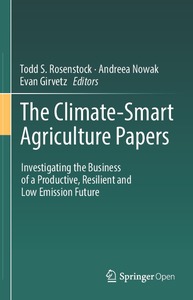| dc.contributor.author | Girvetz, Evan |
| dc.contributor.author | Ramírez Villegas, Julián |
| dc.contributor.author | Claessens, Lieven |
| dc.contributor.author | Lamanna, Christine |
| dc.contributor.author | Navarro-Racines, Carlos |
| dc.contributor.author | Nowak, Andreea |
| dc.contributor.author | Thornton, Philip K. |
| dc.contributor.author | Rosenstock, Todd S. |
| dc.date.accessioned | 2019-12-04T11:27:29Z |
| dc.date.available | 2019-12-04T11:27:29Z |
| dc.date.issued | 2019 |
| dc.identifier.citation | Girvetz, Evan; Ramírez-Villegas, Julian; Claessens, Lieven; Lamanna, Christine; Navarro-Racines, Carlos; Nowak, Andreea; Thornton, Phillip & Rosenstock, Todd S. 2019. Future Climate Projections in Africa: Where Are We Headed?. In: Rosenstock T., Nowak A., Girvetz E. (eds) The Climate-Smart Agriculture Papers. Springer, Cham. 15-27. |
| dc.identifier.uri | https://hdl.handle.net/20.500.12478/4945 |
| dc.description.abstract | This paper offers an overview of how climate change is already affecting farmers across eastern and southern Africa, and how it will continue to affect them in the future. The rising temperatures and increased rainfall variability associated with climate change are undermining the livelihoods and food security of Africa’s farmers, most of whom work at a subsistence level and also face problems of poverty, inadequate infrastructure and poor governance. To address these problems, governments and development organizations have promoted climate-smart agriculture (CSA). These projects, however, have been constrained by inadequate data and predictions regarding future climate change. In particular, farmers in Africa need better projections of the climate hazards for specific regions. Historical weather data at the local level contains many gaps, and the continuing collection of such data could be much improved. Strengthening the database of observed weather is critical to understanding the changes that have occurred already, to project future changes, and to plan appropriately to address them. Once collected and analyzed, climate data must be communicated in ways that help decision-makers understand climate impacts. Good tools are available—such as ClimateWizard.org and Servir ClimateServ—but practitioners at the local level must have the access and training to use them. Even in places where projections are uncertain, steps can be taken now to implement CSA practices and make farmers more resilient in the face of climate change. |
| dc.format.extent | 15-27 |
| dc.language.iso | en |
| dc.publisher | Springer |
| dc.rights | CC-BY-4.0 |
| dc.subject | Climate-Smart Agriculture |
| dc.subject | Climate Change |
| dc.subject | Data |
| dc.subject | Projections |
| dc.subject | Livelihoods |
| dc.subject | Food Security |
| dc.subject | Resilience |
| dc.title | Future Climate Projections in Africa: Where Are We Headed? |
| dc.type | Book Chapter |
| cg.contributor.crp | Climate Change, Agriculture and Food Security |
| cg.contributor.affiliation | International Center for Tropical Agriculture |
| cg.contributor.affiliation | International Institute of Tropical Agriculture |
| cg.contributor.affiliation | World Agroforestry Centre |
| cg.contributor.affiliation | International Livestock Research Institute |
| cg.coverage.region | Africa |
| cg.creator.identifier | Julian Ramirez-Villegas: 0000-0002-8044-583X |
| cg.creator.identifier | Evan Girvetz: 0000-0002-1062-9764 |
| cg.creator.identifier | Carlos Eduardo Navarro-Racines: 0000-0002-8692-6431 |
| cg.howpublished | Formally Published |
| cg.publicationplace | Cham, Switzerland |
| cg.accessibilitystatus | Open Access |
| local.dspaceid | 101986 |
| cg.identifier.doi | https://doi.org/10.1007/978-3-319-92798-5_2 |

